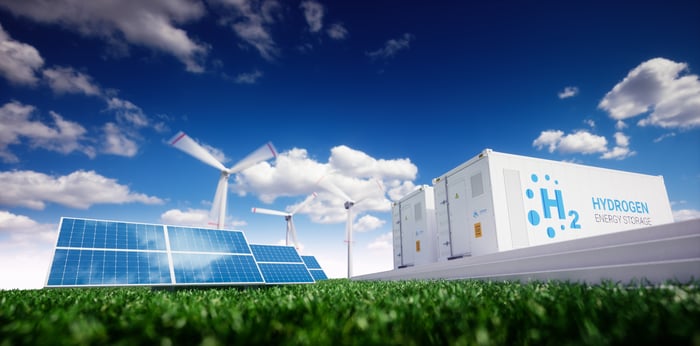Energy Transfer (ET 0.39%) currently owns one of the largest energy infrastructure businesses in North America. The master limited partnership (MLP) operates a fully integrated franchise that moves oil and gas from the wellhead to market centers. It transports more than 25% of all the natural gas and natural gas liquids produced in the U.S. and 35% of its oil. While this infrastructure is vital to meeting the economy's current energy needs, it's starting to transition from fossil fuels to alternative sources like renewable energy.
Energy Transfer needs to join the transition so that it doesn't become extinct. That led it to recently launch an alternative energy group to increase its focus on finding ways to remain relevant as the energy industry shifts fuel sources.

Image source: Getty Images.
Evolving with the industry
Energy Transfer has already started cleaning up its act in recent years. The company has spent the past decade focused on reducing its greenhouse gas emissions. For example, it has installed a dual drive compression system along some of its natural gas pipelines that reduced its carbon dioxide emissions by more than 632,000 tons last year alone. The company also recently supported the construction of the Maplewood 2 Solar Project in Texas by signing a power purchase agreement to buy clean power from that site to offset its energy usage. The company also operates more than 18,000 solar-powered metering stations across the country. As a result, 20% of the electricity it uses comes from renewable energy.
Energy Transfer's new alternative energy group will increase its efforts to find new renewable energy projects. The group will focus on finding opportunities to either purchase power from solar and wind farms or develop projects with third-party operators. Those investments will mainly offset the company's power usage. The company will also look to develop renewable diesel and renewable natural gas opportunities when they make economic sense. These projects would leverage the company's existing pipeline network as it could repurpose some of those assets for renewable fuels.

Image source: Getty Images.
Taking different approaches
Energy Transfer is the latest fossil fuel-focused company to announce plans to increase its participation in the energy transition. Earlier this month, oil giant ExxonMobil (XOM 1.04%) unveiled plans to launch a new business to commercialize its low-carbon technology portfolio. Exxon initially plans to focus on carbon capture and storage projects, though the company also said it would consider other opportunities, including hydrogen. Exxon plans to invest $3 billion in lower-emission energy projects through 2025. However, that's just a drop in the bucket for a company that intends on investing as much as $25 billion per year during that timeframe.
Meanwhile, energy infrastructure operator Kinder Morgan (KMI -0.32%) revealed how it's transitioning to the future of energy earlier this year. It's already involved in storing, handling, and blending liquid renewable transportation fuels like ethanol and biodiesel within its products pipelines and terminals segments. However, it sees ripe opportunities for expansion in renewable diesel. Kinder Morgan also believes it can expand into adjacent markets by blending hydrogen into its existing natural gas network and transporting and sequestering carbon dioxide. Meanwhile, it sees longer-term potential in hydrogen and renewable diesel production and joining Exxon in the carbon capture market. The company believes that it could convert much of its existing infrastructure network to transport and store the fuels of the future.
Meanwhile, other energy companies are taking bolder approaches to capture opportunities in the energy transition. For example, Canadian energy infrastructure giant Enbridge (ENB -0.07%) currently gets about 4% of its earnings from renewable energy assets. It operates 22 wind farms, seven solar farms, six renewable natural gas facilities, and a hydrogen facility, among other assets. Enbridge expects to invest $2 billion Canadian ($1.6 billion) on building additional offshore wind farms in Europe through 2023 and spend another roughly CA$500 million ($393 million) during that timeframe on self-power renewable energy projects in North America. It has several other renewable energy projects in development and other opportunities like carbon capture and storage projects and those focused on hydrogen and renewable natural gas further down the pipeline.
An important first step
Energy Transfer is putting a greater emphasis on discovering its role in the energy transition. It's starting small by looking at self-powering more of its existing infrastructure with renewable energy and exploring ways to leverage those assets to transport renewable fuels. However, with the energy transition accelerating, the company will need to do even more. If it doesn't, it risks falling behind rivals like Enbridge that are already capturing opportunities to create value for their investors by leading the charge in helping the global economy switch power sources.
This article represents the opinion of the writer, who may disagree with the "official" recommendation position of a Motley Fool premium advisory service. We're motley! Questioning an investing thesis -- even one of our own -- helps us all think critically about investing and make decisions that help us become smarter, happier, and richer.





